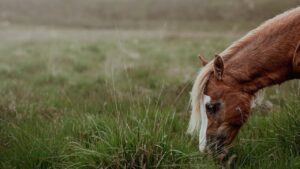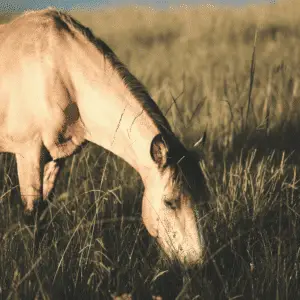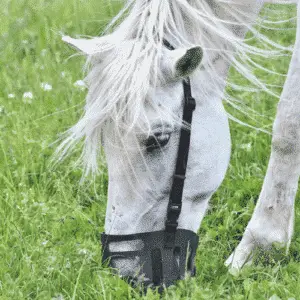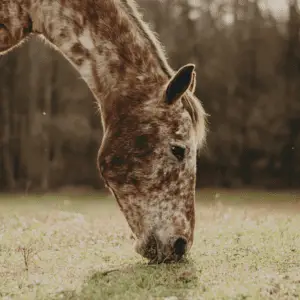
Metabolic Diseases and Fructans: A Risk Factor for Horses?
Metabolic diseases and fructan: a risk factor for horses? Metabolic diseases in horses are on

Is More Always Better?
Some horses have the great fortune to be able to get out out on a large field together with other horses all day long during the summer months. In the best case the field is equipped with hedges, trees, a spacious shelter to protect them against rough weather but also with a good grass composition and a few terrain differences.
Unfortunately, these requirements are rarely met and some types of horses might never adjust to that. Horses need a grass and herb combination that is rich in crude fibre, protein and minerals, but low in sugar and energy in order to be able to feed on it without problems. Due to the intense dairy and meat farming of the past decades the plants that mainly grow on our pastures are intended for cattle. These grass types have plenty of energy, in the form of easily digested carbohydrates, created to heighten milk production and growth on cattle but is unsuitable for a horse’s digestive system.
Even if a horse is more sensitive to these high performance grass types, it can still spend time out with it’s herd, but only with a cautious approach! Here are some tips for sensitive horses:
1. Put on a grazing muzzle
2. Replace the meadow with time on a sand paddock, with other horses
3. Shorten the grazing time but allow a few hours of unrestricted herd life on the field
Here are some advantages and disadvantages of limiting grazing
Advantages:
– Shorter grazing time
– Unrestricted communication through facial expressions – Free movement in the herd
– No risk of injury
– No chafing of the grazing muzzle
Disadvantages:
– More grass intake through fast stress eating – Limited social life
– Risk of laminitis or other fructan related issues
Horses quickly understand that they only have a limited amount of time to consume as much grass as possible once they are out on the field. In a study by the Department of Animal Science at North Carolina State University, scientists found that when grazing 24/7, horses eat about 0.57 g dry matter per kg of bodyweight of dry matter per hour, which means they snooze, sleep, play and cuddle inbetween and nibble on the grass here and there. If the time is reduced to nine hours, the horses eat about 1.2 g of dry matter per kg of bodyweight per hour. They eat more in one place, chew less and pluck one blade of grass after the other a little more hastily. Grooming each other and social behaviour in general receive less attention.
If a horse is only allowed out in the paddock for three hours it can be very stressed. Herd life gets neglected and the horse will minimise movement in order to replace it with grazing.
With free access to basic feed and without the influence of metabolic disorders that increase/decrease appetite, horses normally eat around 14 hours per day, divided in stages. These feeding periods are individual for each horse and are approximately between 30 and 120 minutes. The breaks between are reserved for socialisation and free movement.
In the study mentioned before, it was also noted that horses consume their main grass intake over the first 4 h, with a 67% dry matter intake rate. Still, horses with limited time on grass will often consume more by decreasing their grazing breaks.
Overfeeding can lead to laminitis and other diseases. If the grass is already tall and overgrown the risk is somewhat lower. However, there are times and weather conditions when sugar levels in the form of fructan are very high. These factors should be taken into account when planning the turn out.
For horses that are supposed to slim down, have a diagnosis with certain diseases or might be sensitive to the amounts of sugar, careful consideration should be given to whether grazing the whole day is really necessary. A good alternative for horses that are supposed to slim down or receive treatment for a metabolic disease is putting the horse in a group with the same needs. These herds could be kept on sand paddocks where there’s very little grass available or just hay, straw and tree bark. This way, the horses can be turned out and lead a healthy and relaxed life, even without grazing.
You want to plan the grazing time of your horse? Especially if you can’t be in the stable and are represented by someone? The premium version of the Happie Horse App helps you to track and plan your horse’s time in the field in advance and keep track of its grazing time.
Download the app and try all premium features 7 days for free!

Metabolic diseases and fructan: a risk factor for horses? Metabolic diseases in horses are on

Is More Always Better? Some horses have the great fortune to be able to get

Put an end to fructan worries: Happie Horse app, fructan calendar & co. in comparison

Expert Advice: Kim Lina Pethahn, an independent feed consultant, wrote this article. The Nutritional Benefits

Expert Advice: Kim Lina Pethahn, an independent feed consultant, wrote this article. Advantages and Disadvantages

Basics That Every Horse Person Should Know Often, the pastures which our horses graze on